Measuring Intellectual Capital for Corporate Financial Analysis Report
VerifiedAdded on 2023/06/08
|44
|11757
|468
Report
AI Summary
This research report delves into the critical importance of intellectual capital (IC) measurement and its integration into financial statements for comprehensive corporate analysis. It begins by highlighting the strategic significance of IC assets and their impact on corporate value, emphasizing the need for effective management and reporting. The report then explores various IC valuation methods, presenting competing academic viewpoints and analyzing empirical studies that both support and challenge these models. Furthermore, it provides an evaluation of intangible assets, using case studies of prominent companies like IBM, Dow Chemical, Coca-Cola, and Telia, and calculates Tobin's Q for each. The study investigates the reporting of intangible assets and concludes by discussing the limitations of Tobin's Q. The report also addresses the value relevance of intellectual capital, the influence of IC on corporate value, and the challenges in its valuation. This report, contributed by a student, is a valuable resource for understanding the complexities of intellectual capital in financial reporting and analysis.
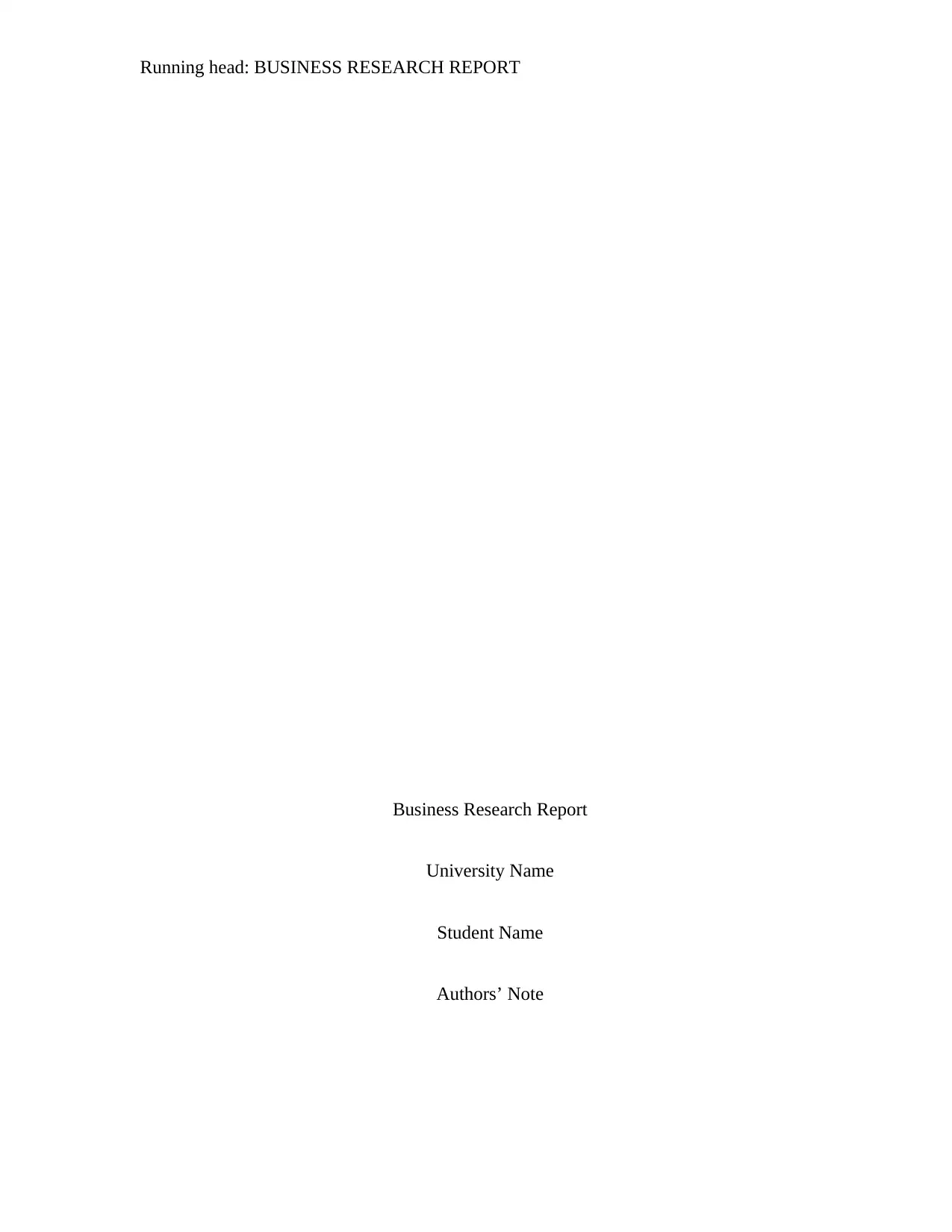
Running head: BUSINESS RESEARCH REPORT
Business Research Report
University Name
Student Name
Authors’ Note
Business Research Report
University Name
Student Name
Authors’ Note
Paraphrase This Document
Need a fresh take? Get an instant paraphrase of this document with our AI Paraphraser
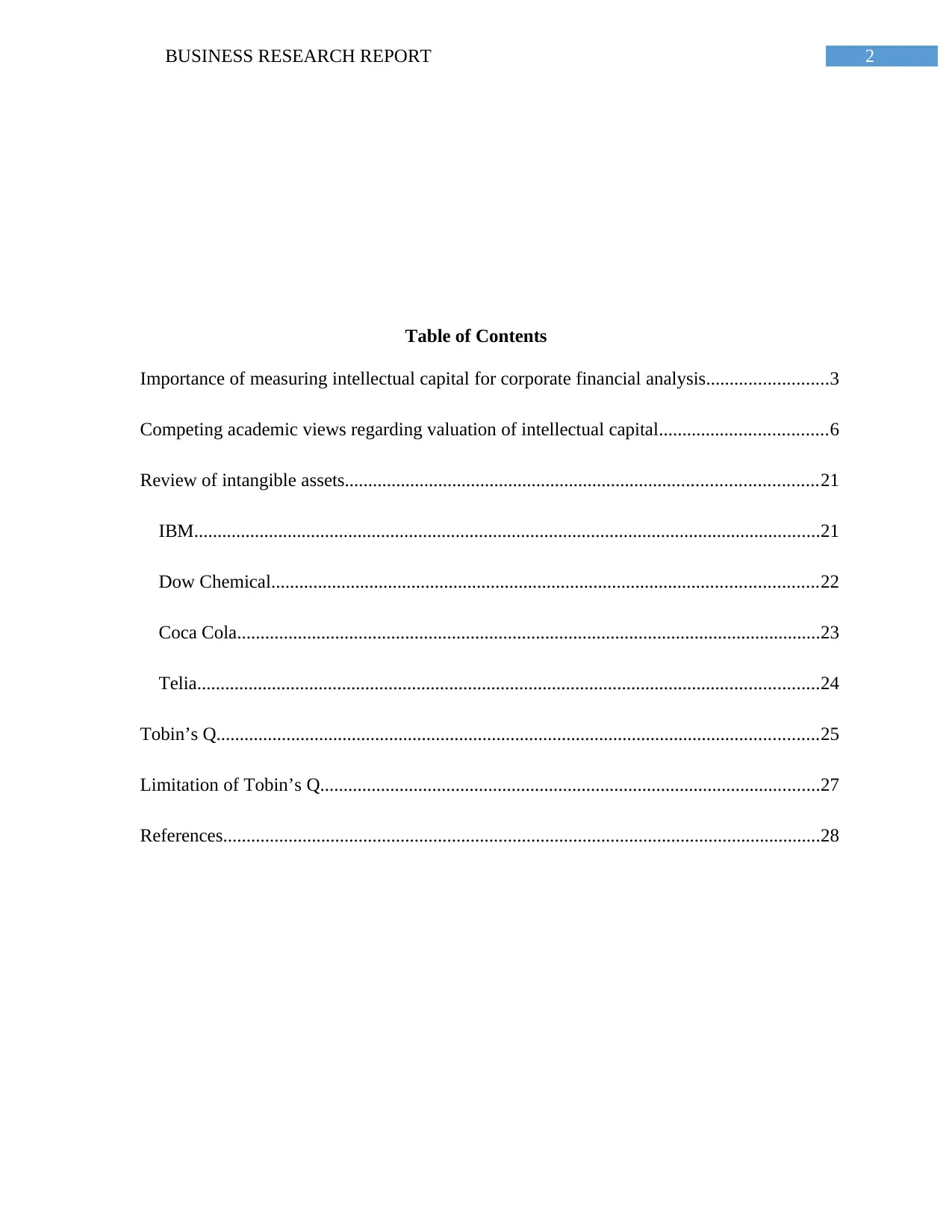
2BUSINESS RESEARCH REPORT
Table of Contents
Importance of measuring intellectual capital for corporate financial analysis..........................3
Competing academic views regarding valuation of intellectual capital....................................6
Review of intangible assets.....................................................................................................21
IBM......................................................................................................................................21
Dow Chemical.....................................................................................................................22
Coca Cola.............................................................................................................................23
Telia.....................................................................................................................................24
Tobin’s Q.................................................................................................................................25
Limitation of Tobin’s Q...........................................................................................................27
References................................................................................................................................28
Table of Contents
Importance of measuring intellectual capital for corporate financial analysis..........................3
Competing academic views regarding valuation of intellectual capital....................................6
Review of intangible assets.....................................................................................................21
IBM......................................................................................................................................21
Dow Chemical.....................................................................................................................22
Coca Cola.............................................................................................................................23
Telia.....................................................................................................................................24
Tobin’s Q.................................................................................................................................25
Limitation of Tobin’s Q...........................................................................................................27
References................................................................................................................................28
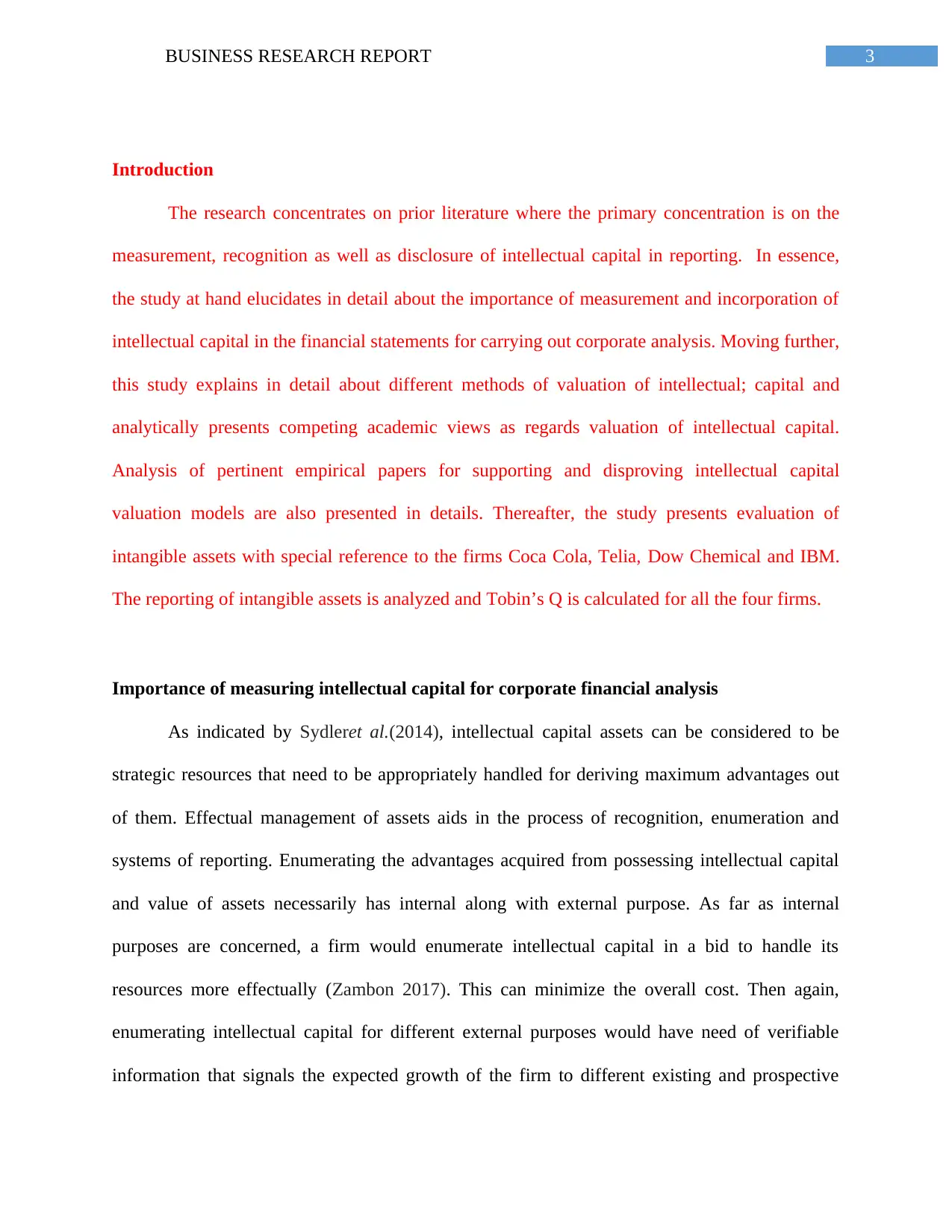
3BUSINESS RESEARCH REPORT
Introduction
The research concentrates on prior literature where the primary concentration is on the
measurement, recognition as well as disclosure of intellectual capital in reporting. In essence,
the study at hand elucidates in detail about the importance of measurement and incorporation of
intellectual capital in the financial statements for carrying out corporate analysis. Moving further,
this study explains in detail about different methods of valuation of intellectual; capital and
analytically presents competing academic views as regards valuation of intellectual capital.
Analysis of pertinent empirical papers for supporting and disproving intellectual capital
valuation models are also presented in details. Thereafter, the study presents evaluation of
intangible assets with special reference to the firms Coca Cola, Telia, Dow Chemical and IBM.
The reporting of intangible assets is analyzed and Tobin’s Q is calculated for all the four firms.
Importance of measuring intellectual capital for corporate financial analysis
As indicated by Sydleret al.(2014), intellectual capital assets can be considered to be
strategic resources that need to be appropriately handled for deriving maximum advantages out
of them. Effectual management of assets aids in the process of recognition, enumeration and
systems of reporting. Enumerating the advantages acquired from possessing intellectual capital
and value of assets necessarily has internal along with external purpose. As far as internal
purposes are concerned, a firm would enumerate intellectual capital in a bid to handle its
resources more effectually (Zambon 2017). This can minimize the overall cost. Then again,
enumerating intellectual capital for different external purposes would have need of verifiable
information that signals the expected growth of the firm to different existing and prospective
Introduction
The research concentrates on prior literature where the primary concentration is on the
measurement, recognition as well as disclosure of intellectual capital in reporting. In essence,
the study at hand elucidates in detail about the importance of measurement and incorporation of
intellectual capital in the financial statements for carrying out corporate analysis. Moving further,
this study explains in detail about different methods of valuation of intellectual; capital and
analytically presents competing academic views as regards valuation of intellectual capital.
Analysis of pertinent empirical papers for supporting and disproving intellectual capital
valuation models are also presented in details. Thereafter, the study presents evaluation of
intangible assets with special reference to the firms Coca Cola, Telia, Dow Chemical and IBM.
The reporting of intangible assets is analyzed and Tobin’s Q is calculated for all the four firms.
Importance of measuring intellectual capital for corporate financial analysis
As indicated by Sydleret al.(2014), intellectual capital assets can be considered to be
strategic resources that need to be appropriately handled for deriving maximum advantages out
of them. Effectual management of assets aids in the process of recognition, enumeration and
systems of reporting. Enumerating the advantages acquired from possessing intellectual capital
and value of assets necessarily has internal along with external purpose. As far as internal
purposes are concerned, a firm would enumerate intellectual capital in a bid to handle its
resources more effectually (Zambon 2017). This can minimize the overall cost. Then again,
enumerating intellectual capital for different external purposes would have need of verifiable
information that signals the expected growth of the firm to different existing and prospective
⊘ This is a preview!⊘
Do you want full access?
Subscribe today to unlock all pages.

Trusted by 1+ million students worldwide
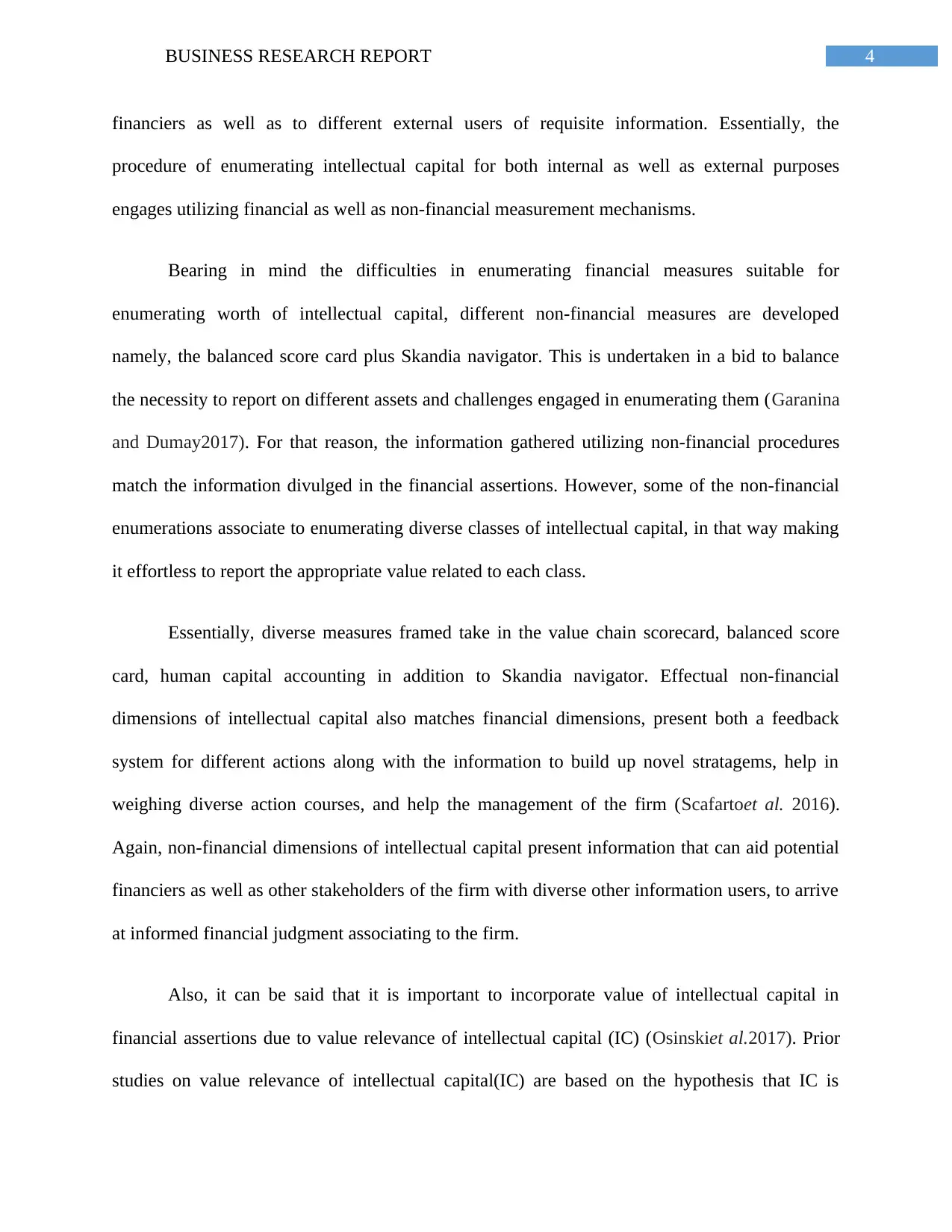
4BUSINESS RESEARCH REPORT
financiers as well as to different external users of requisite information. Essentially, the
procedure of enumerating intellectual capital for both internal as well as external purposes
engages utilizing financial as well as non-financial measurement mechanisms.
Bearing in mind the difficulties in enumerating financial measures suitable for
enumerating worth of intellectual capital, different non-financial measures are developed
namely, the balanced score card plus Skandia navigator. This is undertaken in a bid to balance
the necessity to report on different assets and challenges engaged in enumerating them (Garanina
and Dumay2017). For that reason, the information gathered utilizing non-financial procedures
match the information divulged in the financial assertions. However, some of the non-financial
enumerations associate to enumerating diverse classes of intellectual capital, in that way making
it effortless to report the appropriate value related to each class.
Essentially, diverse measures framed take in the value chain scorecard, balanced score
card, human capital accounting in addition to Skandia navigator. Effectual non-financial
dimensions of intellectual capital also matches financial dimensions, present both a feedback
system for different actions along with the information to build up novel stratagems, help in
weighing diverse action courses, and help the management of the firm (Scafartoet al. 2016).
Again, non-financial dimensions of intellectual capital present information that can aid potential
financiers as well as other stakeholders of the firm with diverse other information users, to arrive
at informed financial judgment associating to the firm.
Also, it can be said that it is important to incorporate value of intellectual capital in
financial assertions due to value relevance of intellectual capital (IC) (Osinskiet al.2017). Prior
studies on value relevance of intellectual capital(IC) are based on the hypothesis that IC is
financiers as well as to different external users of requisite information. Essentially, the
procedure of enumerating intellectual capital for both internal as well as external purposes
engages utilizing financial as well as non-financial measurement mechanisms.
Bearing in mind the difficulties in enumerating financial measures suitable for
enumerating worth of intellectual capital, different non-financial measures are developed
namely, the balanced score card plus Skandia navigator. This is undertaken in a bid to balance
the necessity to report on different assets and challenges engaged in enumerating them (Garanina
and Dumay2017). For that reason, the information gathered utilizing non-financial procedures
match the information divulged in the financial assertions. However, some of the non-financial
enumerations associate to enumerating diverse classes of intellectual capital, in that way making
it effortless to report the appropriate value related to each class.
Essentially, diverse measures framed take in the value chain scorecard, balanced score
card, human capital accounting in addition to Skandia navigator. Effectual non-financial
dimensions of intellectual capital also matches financial dimensions, present both a feedback
system for different actions along with the information to build up novel stratagems, help in
weighing diverse action courses, and help the management of the firm (Scafartoet al. 2016).
Again, non-financial dimensions of intellectual capital present information that can aid potential
financiers as well as other stakeholders of the firm with diverse other information users, to arrive
at informed financial judgment associating to the firm.
Also, it can be said that it is important to incorporate value of intellectual capital in
financial assertions due to value relevance of intellectual capital (IC) (Osinskiet al.2017). Prior
studies on value relevance of intellectual capital(IC) are based on the hypothesis that IC is
Paraphrase This Document
Need a fresh take? Get an instant paraphrase of this document with our AI Paraphraser
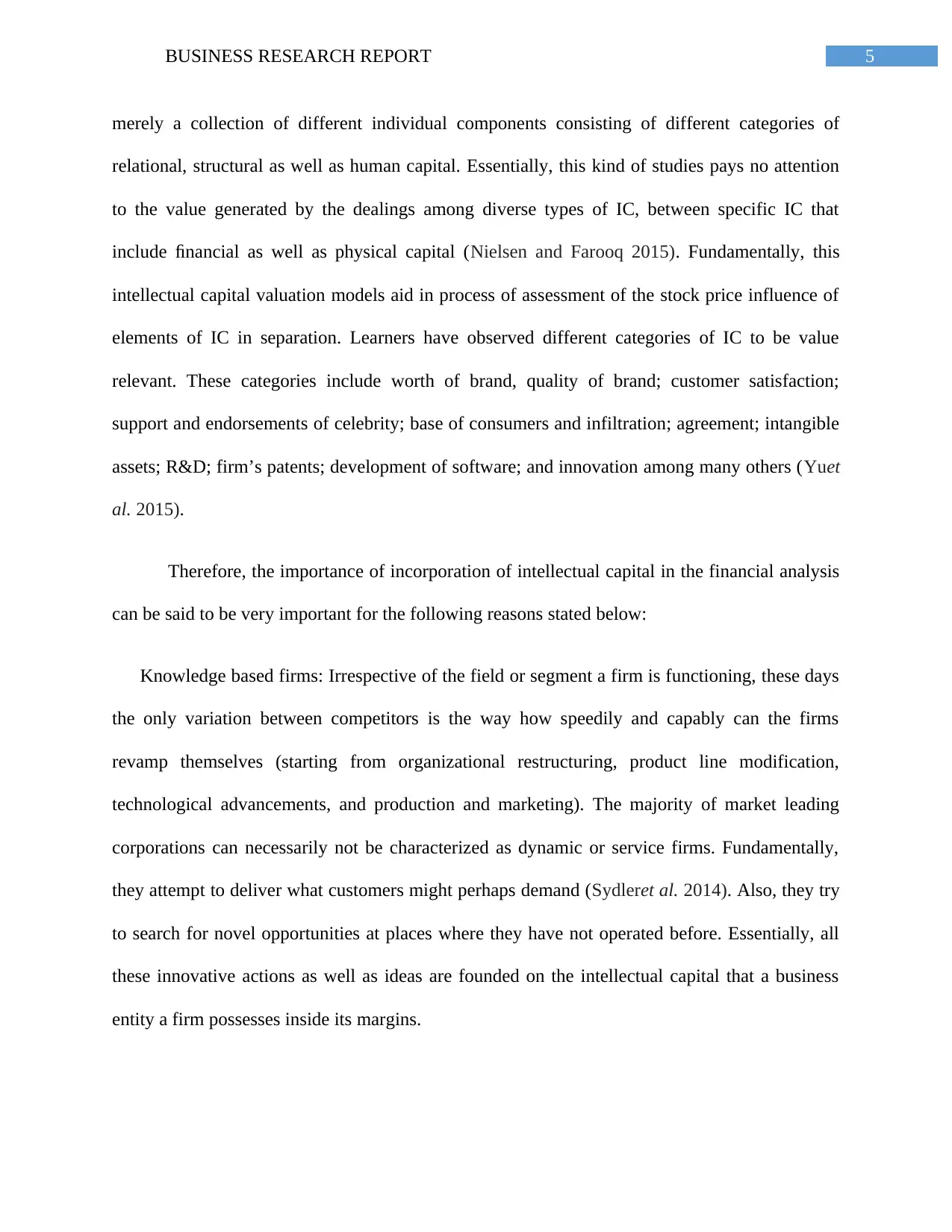
5BUSINESS RESEARCH REPORT
merely a collection of different individual components consisting of different categories of
relational, structural as well as human capital. Essentially, this kind of studies pays no attention
to the value generated by the dealings among diverse types of IC, between specific IC that
include financial as well as physical capital (Nielsen and Farooq 2015). Fundamentally, this
intellectual capital valuation models aid in process of assessment of the stock price influence of
elements of IC in separation. Learners have observed different categories of IC to be value
relevant. These categories include worth of brand, quality of brand; customer satisfaction;
support and endorsements of celebrity; base of consumers and infiltration; agreement; intangible
assets; R&D; firm’s patents; development of software; and innovation among many others (Yuet
al. 2015).
Therefore, the importance of incorporation of intellectual capital in the financial analysis
can be said to be very important for the following reasons stated below:
Knowledge based firms: Irrespective of the field or segment a firm is functioning, these days
the only variation between competitors is the way how speedily and capably can the firms
revamp themselves (starting from organizational restructuring, product line modification,
technological advancements, and production and marketing). The majority of market leading
corporations can necessarily not be characterized as dynamic or service firms. Fundamentally,
they attempt to deliver what customers might perhaps demand (Sydleret al. 2014). Also, they try
to search for novel opportunities at places where they have not operated before. Essentially, all
these innovative actions as well as ideas are founded on the intellectual capital that a business
entity a firm possesses inside its margins.
merely a collection of different individual components consisting of different categories of
relational, structural as well as human capital. Essentially, this kind of studies pays no attention
to the value generated by the dealings among diverse types of IC, between specific IC that
include financial as well as physical capital (Nielsen and Farooq 2015). Fundamentally, this
intellectual capital valuation models aid in process of assessment of the stock price influence of
elements of IC in separation. Learners have observed different categories of IC to be value
relevant. These categories include worth of brand, quality of brand; customer satisfaction;
support and endorsements of celebrity; base of consumers and infiltration; agreement; intangible
assets; R&D; firm’s patents; development of software; and innovation among many others (Yuet
al. 2015).
Therefore, the importance of incorporation of intellectual capital in the financial analysis
can be said to be very important for the following reasons stated below:
Knowledge based firms: Irrespective of the field or segment a firm is functioning, these days
the only variation between competitors is the way how speedily and capably can the firms
revamp themselves (starting from organizational restructuring, product line modification,
technological advancements, and production and marketing). The majority of market leading
corporations can necessarily not be characterized as dynamic or service firms. Fundamentally,
they attempt to deliver what customers might perhaps demand (Sydleret al. 2014). Also, they try
to search for novel opportunities at places where they have not operated before. Essentially, all
these innovative actions as well as ideas are founded on the intellectual capital that a business
entity a firm possesses inside its margins.
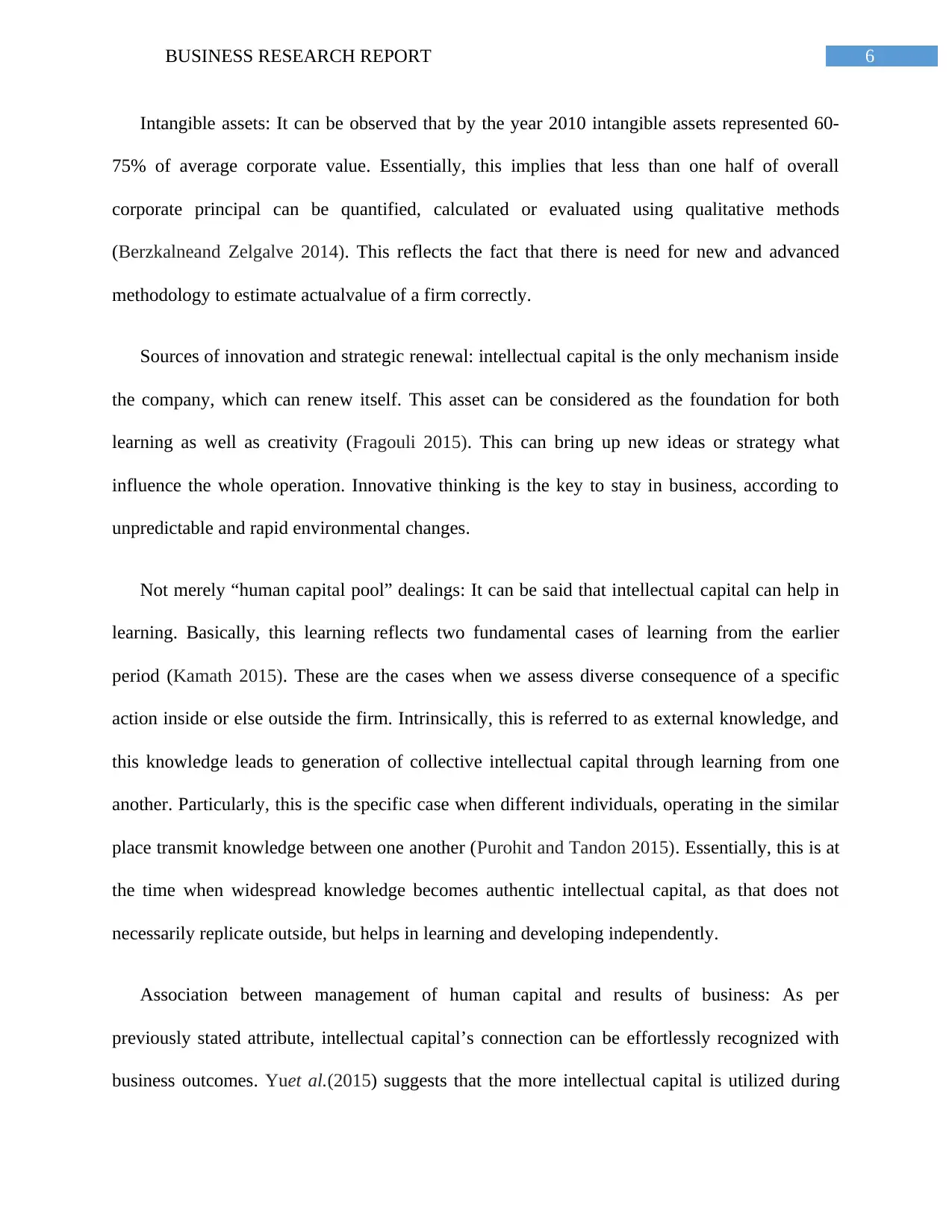
6BUSINESS RESEARCH REPORT
Intangible assets: It can be observed that by the year 2010 intangible assets represented 60-
75% of average corporate value. Essentially, this implies that less than one half of overall
corporate principal can be quantified, calculated or evaluated using qualitative methods
(Berzkalneand Zelgalve 2014). This reflects the fact that there is need for new and advanced
methodology to estimate actualvalue of a firm correctly.
Sources of innovation and strategic renewal: intellectual capital is the only mechanism inside
the company, which can renew itself. This asset can be considered as the foundation for both
learning as well as creativity (Fragouli 2015). This can bring up new ideas or strategy what
influence the whole operation. Innovative thinking is the key to stay in business, according to
unpredictable and rapid environmental changes.
Not merely “human capital pool” dealings: It can be said that intellectual capital can help in
learning. Basically, this learning reflects two fundamental cases of learning from the earlier
period (Kamath 2015). These are the cases when we assess diverse consequence of a specific
action inside or else outside the firm. Intrinsically, this is referred to as external knowledge, and
this knowledge leads to generation of collective intellectual capital through learning from one
another. Particularly, this is the specific case when different individuals, operating in the similar
place transmit knowledge between one another (Purohit and Tandon 2015). Essentially, this is at
the time when widespread knowledge becomes authentic intellectual capital, as that does not
necessarily replicate outside, but helps in learning and developing independently.
Association between management of human capital and results of business: As per
previously stated attribute, intellectual capital’s connection can be effortlessly recognized with
business outcomes. Yuet al.(2015) suggests that the more intellectual capital is utilized during
Intangible assets: It can be observed that by the year 2010 intangible assets represented 60-
75% of average corporate value. Essentially, this implies that less than one half of overall
corporate principal can be quantified, calculated or evaluated using qualitative methods
(Berzkalneand Zelgalve 2014). This reflects the fact that there is need for new and advanced
methodology to estimate actualvalue of a firm correctly.
Sources of innovation and strategic renewal: intellectual capital is the only mechanism inside
the company, which can renew itself. This asset can be considered as the foundation for both
learning as well as creativity (Fragouli 2015). This can bring up new ideas or strategy what
influence the whole operation. Innovative thinking is the key to stay in business, according to
unpredictable and rapid environmental changes.
Not merely “human capital pool” dealings: It can be said that intellectual capital can help in
learning. Basically, this learning reflects two fundamental cases of learning from the earlier
period (Kamath 2015). These are the cases when we assess diverse consequence of a specific
action inside or else outside the firm. Intrinsically, this is referred to as external knowledge, and
this knowledge leads to generation of collective intellectual capital through learning from one
another. Particularly, this is the specific case when different individuals, operating in the similar
place transmit knowledge between one another (Purohit and Tandon 2015). Essentially, this is at
the time when widespread knowledge becomes authentic intellectual capital, as that does not
necessarily replicate outside, but helps in learning and developing independently.
Association between management of human capital and results of business: As per
previously stated attribute, intellectual capital’s connection can be effortlessly recognized with
business outcomes. Yuet al.(2015) suggests that the more intellectual capital is utilized during
⊘ This is a preview!⊘
Do you want full access?
Subscribe today to unlock all pages.

Trusted by 1+ million students worldwide
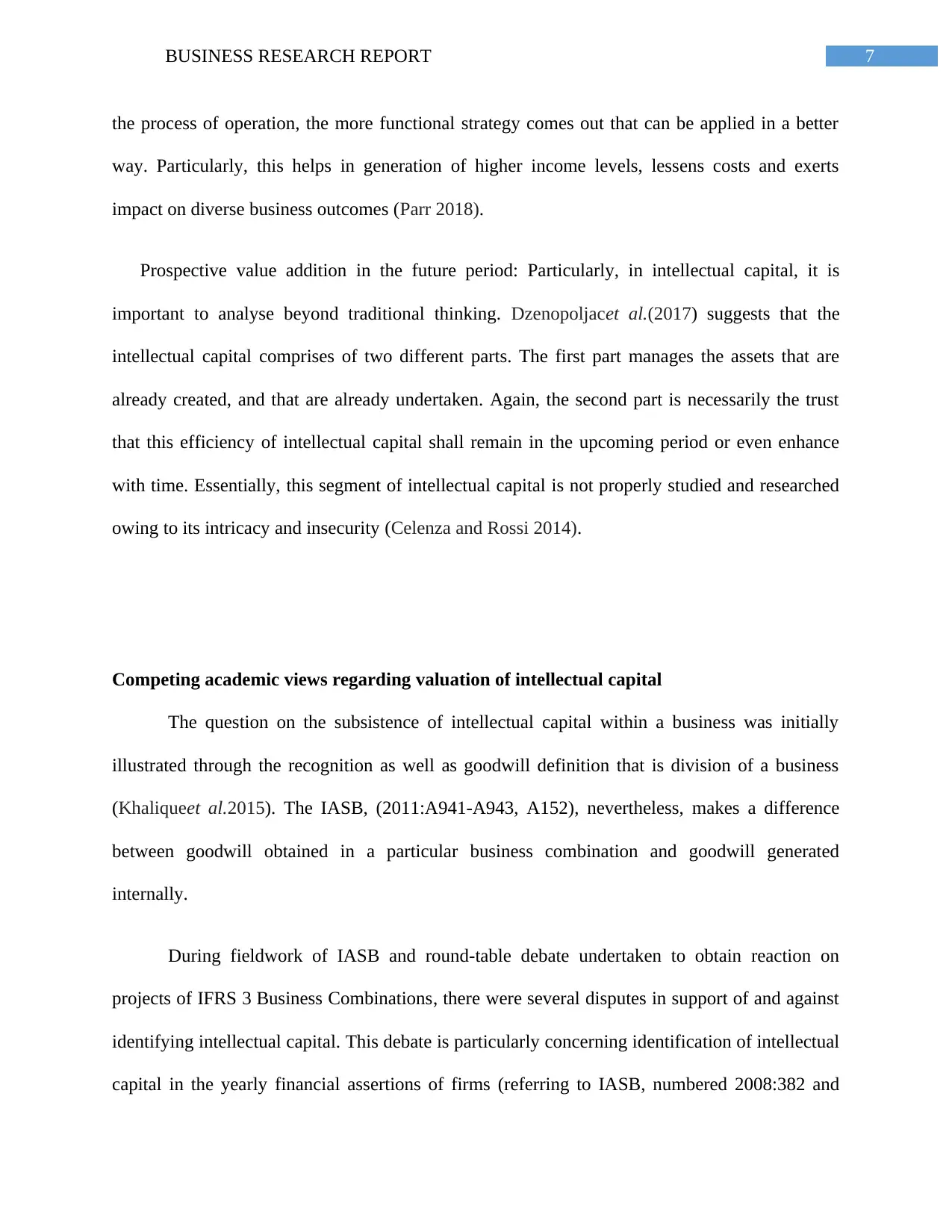
7BUSINESS RESEARCH REPORT
the process of operation, the more functional strategy comes out that can be applied in a better
way. Particularly, this helps in generation of higher income levels, lessens costs and exerts
impact on diverse business outcomes (Parr 2018).
Prospective value addition in the future period: Particularly, in intellectual capital, it is
important to analyse beyond traditional thinking. Dzenopoljacet al.(2017) suggests that the
intellectual capital comprises of two different parts. The first part manages the assets that are
already created, and that are already undertaken. Again, the second part is necessarily the trust
that this efficiency of intellectual capital shall remain in the upcoming period or even enhance
with time. Essentially, this segment of intellectual capital is not properly studied and researched
owing to its intricacy and insecurity (Celenza and Rossi 2014).
Competing academic views regarding valuation of intellectual capital
The question on the subsistence of intellectual capital within a business was initially
illustrated through the recognition as well as goodwill definition that is division of a business
(Khaliqueet al.2015). The IASB, (2011:A941-A943, A152), nevertheless, makes a difference
between goodwill obtained in a particular business combination and goodwill generated
internally.
During fieldwork of IASB and round-table debate undertaken to obtain reaction on
projects of IFRS 3 Business Combinations, there were several disputes in support of and against
identifying intellectual capital. This debate is particularly concerning identification of intellectual
capital in the yearly financial assertions of firms (referring to IASB, numbered 2008:382 and
the process of operation, the more functional strategy comes out that can be applied in a better
way. Particularly, this helps in generation of higher income levels, lessens costs and exerts
impact on diverse business outcomes (Parr 2018).
Prospective value addition in the future period: Particularly, in intellectual capital, it is
important to analyse beyond traditional thinking. Dzenopoljacet al.(2017) suggests that the
intellectual capital comprises of two different parts. The first part manages the assets that are
already created, and that are already undertaken. Again, the second part is necessarily the trust
that this efficiency of intellectual capital shall remain in the upcoming period or even enhance
with time. Essentially, this segment of intellectual capital is not properly studied and researched
owing to its intricacy and insecurity (Celenza and Rossi 2014).
Competing academic views regarding valuation of intellectual capital
The question on the subsistence of intellectual capital within a business was initially
illustrated through the recognition as well as goodwill definition that is division of a business
(Khaliqueet al.2015). The IASB, (2011:A941-A943, A152), nevertheless, makes a difference
between goodwill obtained in a particular business combination and goodwill generated
internally.
During fieldwork of IASB and round-table debate undertaken to obtain reaction on
projects of IFRS 3 Business Combinations, there were several disputes in support of and against
identifying intellectual capital. This debate is particularly concerning identification of intellectual
capital in the yearly financial assertions of firms (referring to IASB, numbered 2008:382 and
Paraphrase This Document
Need a fresh take? Get an instant paraphrase of this document with our AI Paraphraser
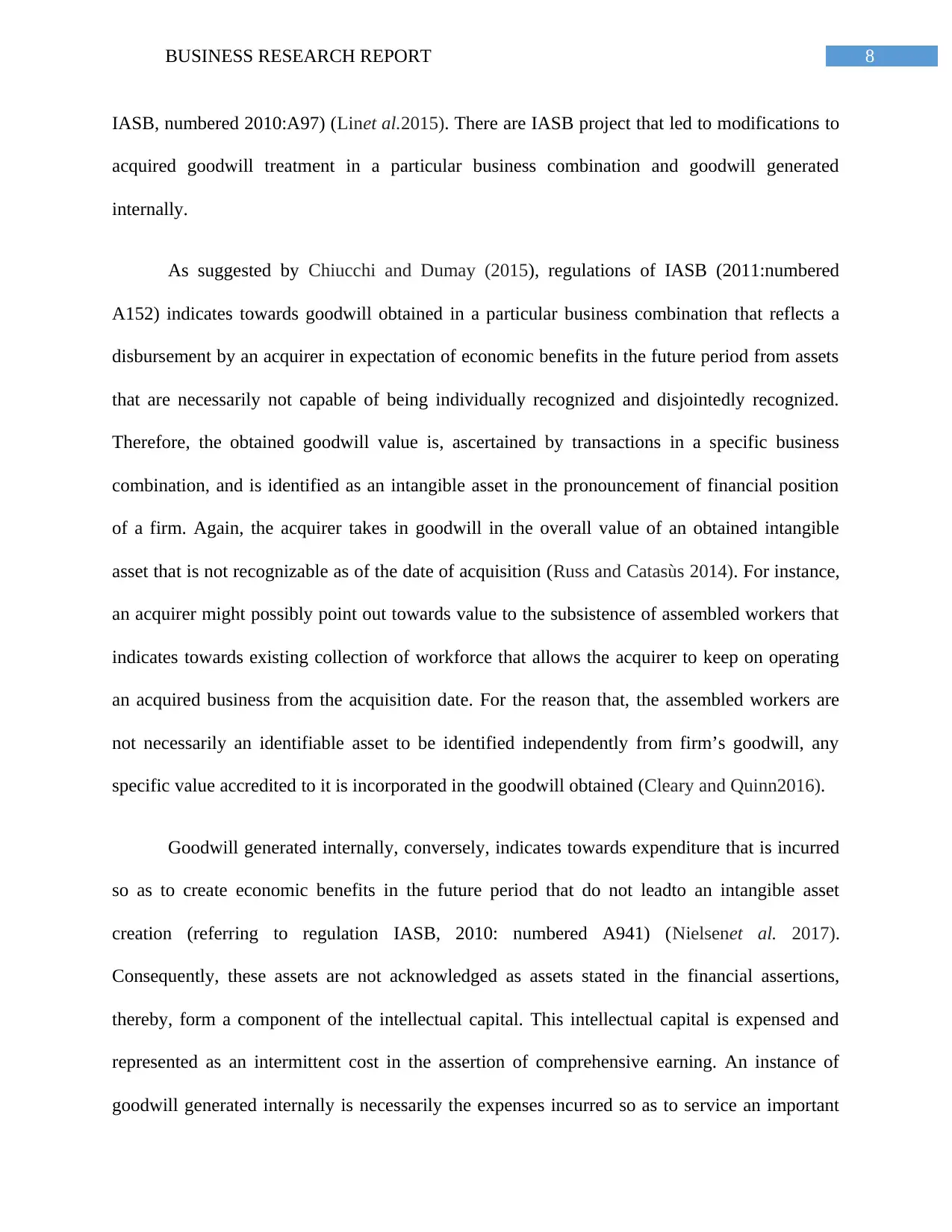
8BUSINESS RESEARCH REPORT
IASB, numbered 2010:A97) (Linet al.2015). There are IASB project that led to modifications to
acquired goodwill treatment in a particular business combination and goodwill generated
internally.
As suggested by Chiucchi and Dumay (2015), regulations of IASB (2011:numbered
A152) indicates towards goodwill obtained in a particular business combination that reflects a
disbursement by an acquirer in expectation of economic benefits in the future period from assets
that are necessarily not capable of being individually recognized and disjointedly recognized.
Therefore, the obtained goodwill value is, ascertained by transactions in a specific business
combination, and is identified as an intangible asset in the pronouncement of financial position
of a firm. Again, the acquirer takes in goodwill in the overall value of an obtained intangible
asset that is not recognizable as of the date of acquisition (Russ and Catasùs 2014). For instance,
an acquirer might possibly point out towards value to the subsistence of assembled workers that
indicates towards existing collection of workforce that allows the acquirer to keep on operating
an acquired business from the acquisition date. For the reason that, the assembled workers are
not necessarily an identifiable asset to be identified independently from firm’s goodwill, any
specific value accredited to it is incorporated in the goodwill obtained (Cleary and Quinn2016).
Goodwill generated internally, conversely, indicates towards expenditure that is incurred
so as to create economic benefits in the future period that do not leadto an intangible asset
creation (referring to regulation IASB, 2010: numbered A941) (Nielsenet al. 2017).
Consequently, these assets are not acknowledged as assets stated in the financial assertions,
thereby, form a component of the intellectual capital. This intellectual capital is expensed and
represented as an intermittent cost in the assertion of comprehensive earning. An instance of
goodwill generated internally is necessarily the expenses incurred so as to service an important
IASB, numbered 2010:A97) (Linet al.2015). There are IASB project that led to modifications to
acquired goodwill treatment in a particular business combination and goodwill generated
internally.
As suggested by Chiucchi and Dumay (2015), regulations of IASB (2011:numbered
A152) indicates towards goodwill obtained in a particular business combination that reflects a
disbursement by an acquirer in expectation of economic benefits in the future period from assets
that are necessarily not capable of being individually recognized and disjointedly recognized.
Therefore, the obtained goodwill value is, ascertained by transactions in a specific business
combination, and is identified as an intangible asset in the pronouncement of financial position
of a firm. Again, the acquirer takes in goodwill in the overall value of an obtained intangible
asset that is not recognizable as of the date of acquisition (Russ and Catasùs 2014). For instance,
an acquirer might possibly point out towards value to the subsistence of assembled workers that
indicates towards existing collection of workforce that allows the acquirer to keep on operating
an acquired business from the acquisition date. For the reason that, the assembled workers are
not necessarily an identifiable asset to be identified independently from firm’s goodwill, any
specific value accredited to it is incorporated in the goodwill obtained (Cleary and Quinn2016).
Goodwill generated internally, conversely, indicates towards expenditure that is incurred
so as to create economic benefits in the future period that do not leadto an intangible asset
creation (referring to regulation IASB, 2010: numbered A941) (Nielsenet al. 2017).
Consequently, these assets are not acknowledged as assets stated in the financial assertions,
thereby, form a component of the intellectual capital. This intellectual capital is expensed and
represented as an intermittent cost in the assertion of comprehensive earning. An instance of
goodwill generated internally is necessarily the expenses incurred so as to service an important
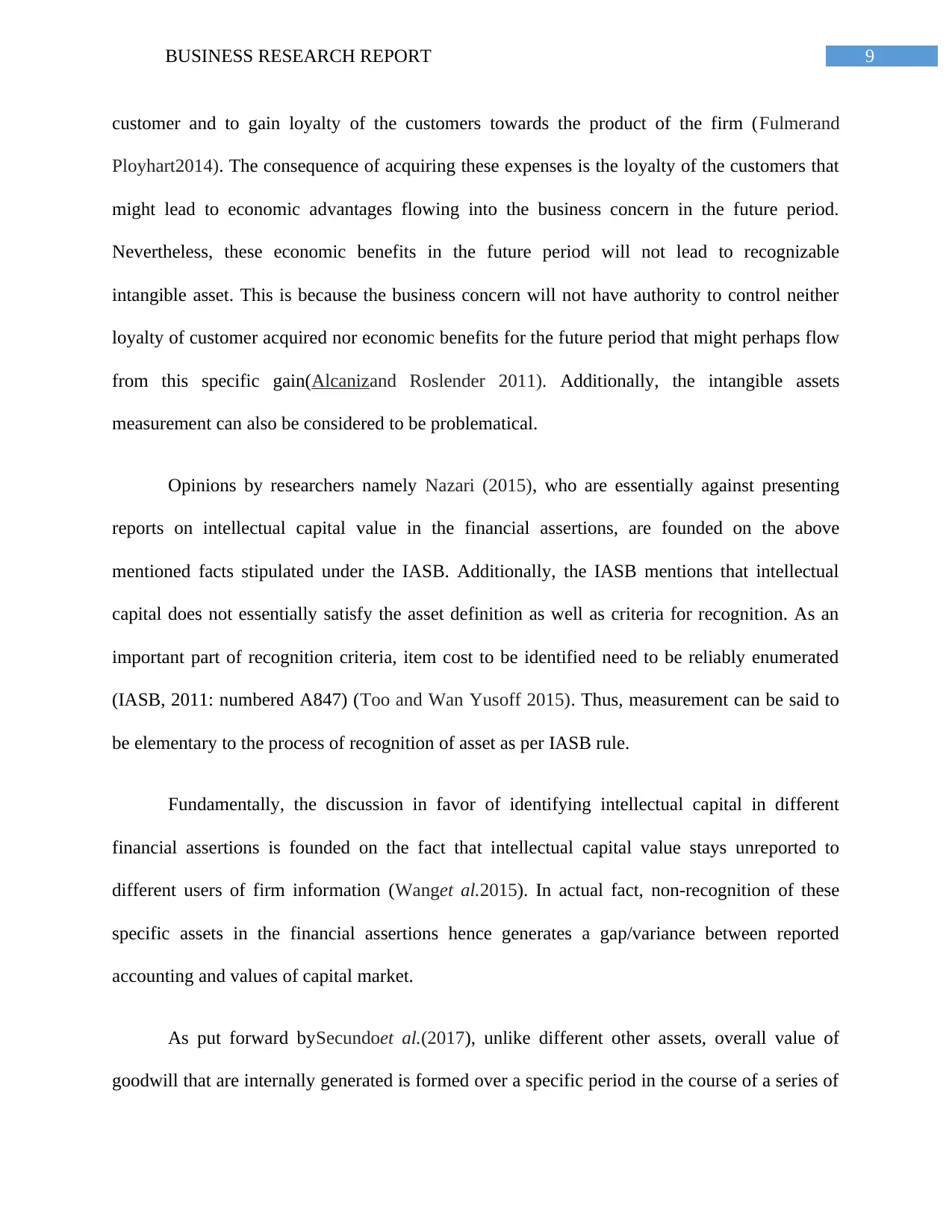
9BUSINESS RESEARCH REPORT
customer and to gain loyalty of the customers towards the product of the firm (Fulmerand
Ployhart2014). The consequence of acquiring these expenses is the loyalty of the customers that
might lead to economic advantages flowing into the business concern in the future period.
Nevertheless, these economic benefits in the future period will not lead to recognizable
intangible asset. This is because the business concern will not have authority to control neither
loyalty of customer acquired nor economic benefits for the future period that might perhaps flow
from this specific gain(Alcanizand Roslender 2011). Additionally, the intangible assets
measurement can also be considered to be problematical.
Opinions by researchers namely Nazari (2015), who are essentially against presenting
reports on intellectual capital value in the financial assertions, are founded on the above
mentioned facts stipulated under the IASB. Additionally, the IASB mentions that intellectual
capital does not essentially satisfy the asset definition as well as criteria for recognition. As an
important part of recognition criteria, item cost to be identified need to be reliably enumerated
(IASB, 2011: numbered A847) (Too and Wan Yusoff 2015). Thus, measurement can be said to
be elementary to the process of recognition of asset as per IASB rule.
Fundamentally, the discussion in favor of identifying intellectual capital in different
financial assertions is founded on the fact that intellectual capital value stays unreported to
different users of firm information (Wanget al.2015). In actual fact, non-recognition of these
specific assets in the financial assertions hence generates a gap/variance between reported
accounting and values of capital market.
As put forward bySecundoet al.(2017), unlike different other assets, overall value of
goodwill that are internally generated is formed over a specific period in the course of a series of
customer and to gain loyalty of the customers towards the product of the firm (Fulmerand
Ployhart2014). The consequence of acquiring these expenses is the loyalty of the customers that
might lead to economic advantages flowing into the business concern in the future period.
Nevertheless, these economic benefits in the future period will not lead to recognizable
intangible asset. This is because the business concern will not have authority to control neither
loyalty of customer acquired nor economic benefits for the future period that might perhaps flow
from this specific gain(Alcanizand Roslender 2011). Additionally, the intangible assets
measurement can also be considered to be problematical.
Opinions by researchers namely Nazari (2015), who are essentially against presenting
reports on intellectual capital value in the financial assertions, are founded on the above
mentioned facts stipulated under the IASB. Additionally, the IASB mentions that intellectual
capital does not essentially satisfy the asset definition as well as criteria for recognition. As an
important part of recognition criteria, item cost to be identified need to be reliably enumerated
(IASB, 2011: numbered A847) (Too and Wan Yusoff 2015). Thus, measurement can be said to
be elementary to the process of recognition of asset as per IASB rule.
Fundamentally, the discussion in favor of identifying intellectual capital in different
financial assertions is founded on the fact that intellectual capital value stays unreported to
different users of firm information (Wanget al.2015). In actual fact, non-recognition of these
specific assets in the financial assertions hence generates a gap/variance between reported
accounting and values of capital market.
As put forward bySecundoet al.(2017), unlike different other assets, overall value of
goodwill that are internally generated is formed over a specific period in the course of a series of
⊘ This is a preview!⊘
Do you want full access?
Subscribe today to unlock all pages.

Trusted by 1+ million students worldwide
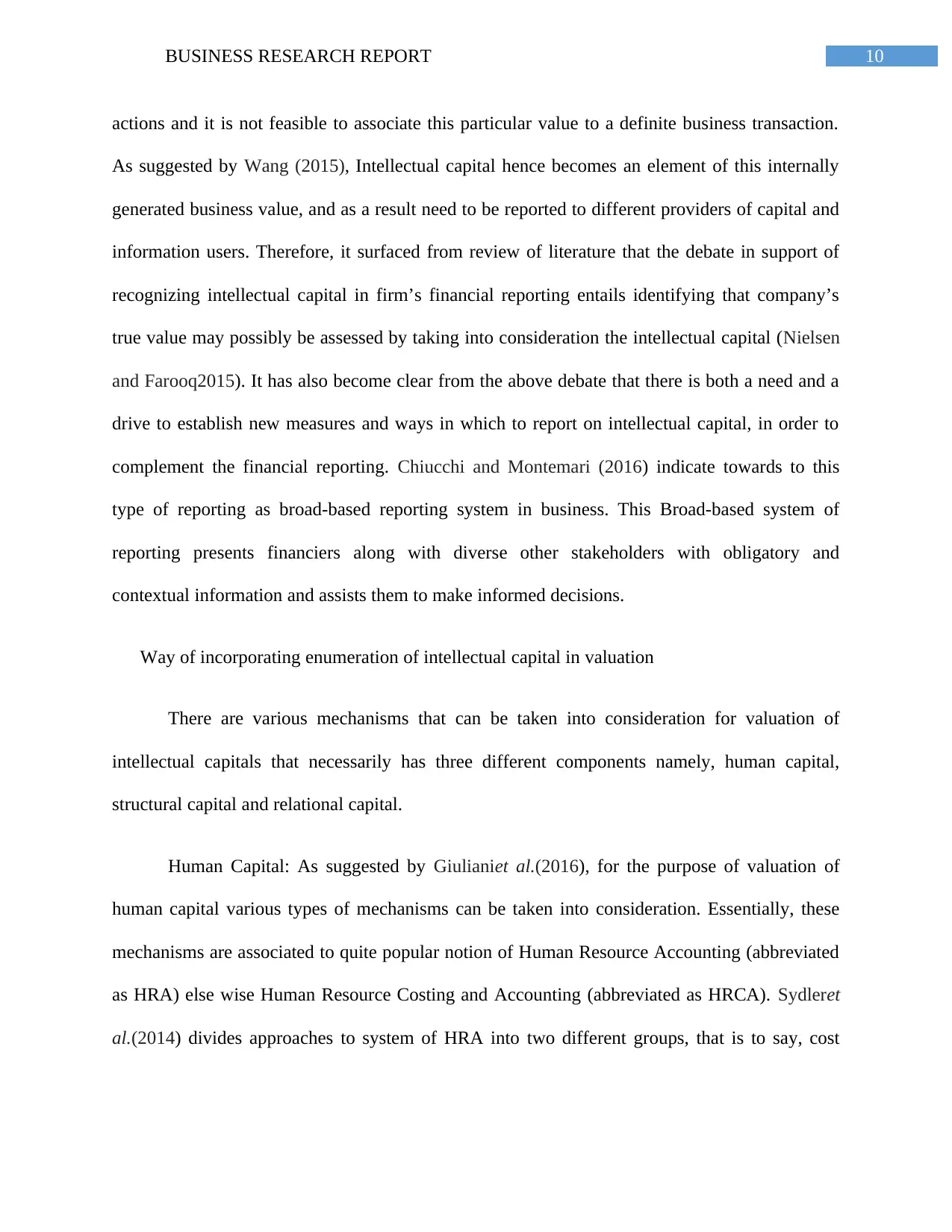
10BUSINESS RESEARCH REPORT
actions and it is not feasible to associate this particular value to a definite business transaction.
As suggested by Wang (2015), Intellectual capital hence becomes an element of this internally
generated business value, and as a result need to be reported to different providers of capital and
information users. Therefore, it surfaced from review of literature that the debate in support of
recognizing intellectual capital in firm’s financial reporting entails identifying that company’s
true value may possibly be assessed by taking into consideration the intellectual capital (Nielsen
and Farooq2015). It has also become clear from the above debate that there is both a need and a
drive to establish new measures and ways in which to report on intellectual capital, in order to
complement the financial reporting. Chiucchi and Montemari (2016) indicate towards to this
type of reporting as broad-based reporting system in business. This Broad-based system of
reporting presents financiers along with diverse other stakeholders with obligatory and
contextual information and assists them to make informed decisions.
Way of incorporating enumeration of intellectual capital in valuation
There are various mechanisms that can be taken into consideration for valuation of
intellectual capitals that necessarily has three different components namely, human capital,
structural capital and relational capital.
Human Capital: As suggested by Giulianiet al.(2016), for the purpose of valuation of
human capital various types of mechanisms can be taken into consideration. Essentially, these
mechanisms are associated to quite popular notion of Human Resource Accounting (abbreviated
as HRA) else wise Human Resource Costing and Accounting (abbreviated as HRCA). Sydleret
al.(2014) divides approaches to system of HRA into two different groups, that is to say, cost
actions and it is not feasible to associate this particular value to a definite business transaction.
As suggested by Wang (2015), Intellectual capital hence becomes an element of this internally
generated business value, and as a result need to be reported to different providers of capital and
information users. Therefore, it surfaced from review of literature that the debate in support of
recognizing intellectual capital in firm’s financial reporting entails identifying that company’s
true value may possibly be assessed by taking into consideration the intellectual capital (Nielsen
and Farooq2015). It has also become clear from the above debate that there is both a need and a
drive to establish new measures and ways in which to report on intellectual capital, in order to
complement the financial reporting. Chiucchi and Montemari (2016) indicate towards to this
type of reporting as broad-based reporting system in business. This Broad-based system of
reporting presents financiers along with diverse other stakeholders with obligatory and
contextual information and assists them to make informed decisions.
Way of incorporating enumeration of intellectual capital in valuation
There are various mechanisms that can be taken into consideration for valuation of
intellectual capitals that necessarily has three different components namely, human capital,
structural capital and relational capital.
Human Capital: As suggested by Giulianiet al.(2016), for the purpose of valuation of
human capital various types of mechanisms can be taken into consideration. Essentially, these
mechanisms are associated to quite popular notion of Human Resource Accounting (abbreviated
as HRA) else wise Human Resource Costing and Accounting (abbreviated as HRCA). Sydleret
al.(2014) divides approaches to system of HRA into two different groups, that is to say, cost
Paraphrase This Document
Need a fresh take? Get an instant paraphrase of this document with our AI Paraphraser
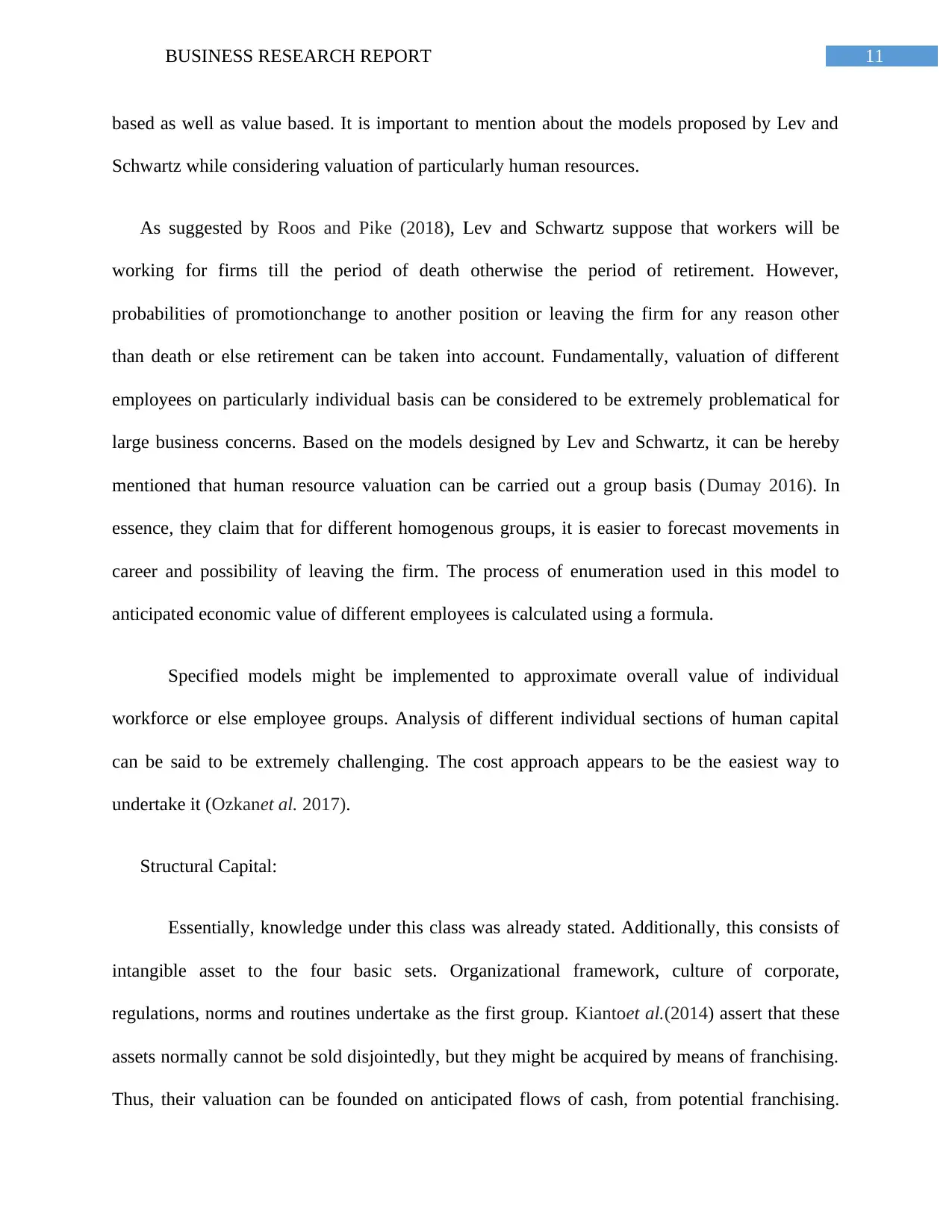
11BUSINESS RESEARCH REPORT
based as well as value based. It is important to mention about the models proposed by Lev and
Schwartz while considering valuation of particularly human resources.
As suggested by Roos and Pike (2018), Lev and Schwartz suppose that workers will be
working for firms till the period of death otherwise the period of retirement. However,
probabilities of promotionchange to another position or leaving the firm for any reason other
than death or else retirement can be taken into account. Fundamentally, valuation of different
employees on particularly individual basis can be considered to be extremely problematical for
large business concerns. Based on the models designed by Lev and Schwartz, it can be hereby
mentioned that human resource valuation can be carried out a group basis (Dumay 2016). In
essence, they claim that for different homogenous groups, it is easier to forecast movements in
career and possibility of leaving the firm. The process of enumeration used in this model to
anticipated economic value of different employees is calculated using a formula.
Specified models might be implemented to approximate overall value of individual
workforce or else employee groups. Analysis of different individual sections of human capital
can be said to be extremely challenging. The cost approach appears to be the easiest way to
undertake it (Ozkanet al. 2017).
Structural Capital:
Essentially, knowledge under this class was already stated. Additionally, this consists of
intangible asset to the four basic sets. Organizational framework, culture of corporate,
regulations, norms and routines undertake as the first group. Kiantoet al.(2014) assert that these
assets normally cannot be sold disjointedly, but they might be acquired by means of franchising.
Thus, their valuation can be founded on anticipated flows of cash, from potential franchising.
based as well as value based. It is important to mention about the models proposed by Lev and
Schwartz while considering valuation of particularly human resources.
As suggested by Roos and Pike (2018), Lev and Schwartz suppose that workers will be
working for firms till the period of death otherwise the period of retirement. However,
probabilities of promotionchange to another position or leaving the firm for any reason other
than death or else retirement can be taken into account. Fundamentally, valuation of different
employees on particularly individual basis can be considered to be extremely problematical for
large business concerns. Based on the models designed by Lev and Schwartz, it can be hereby
mentioned that human resource valuation can be carried out a group basis (Dumay 2016). In
essence, they claim that for different homogenous groups, it is easier to forecast movements in
career and possibility of leaving the firm. The process of enumeration used in this model to
anticipated economic value of different employees is calculated using a formula.
Specified models might be implemented to approximate overall value of individual
workforce or else employee groups. Analysis of different individual sections of human capital
can be said to be extremely challenging. The cost approach appears to be the easiest way to
undertake it (Ozkanet al. 2017).
Structural Capital:
Essentially, knowledge under this class was already stated. Additionally, this consists of
intangible asset to the four basic sets. Organizational framework, culture of corporate,
regulations, norms and routines undertake as the first group. Kiantoet al.(2014) assert that these
assets normally cannot be sold disjointedly, but they might be acquired by means of franchising.
Thus, their valuation can be founded on anticipated flows of cash, from potential franchising.
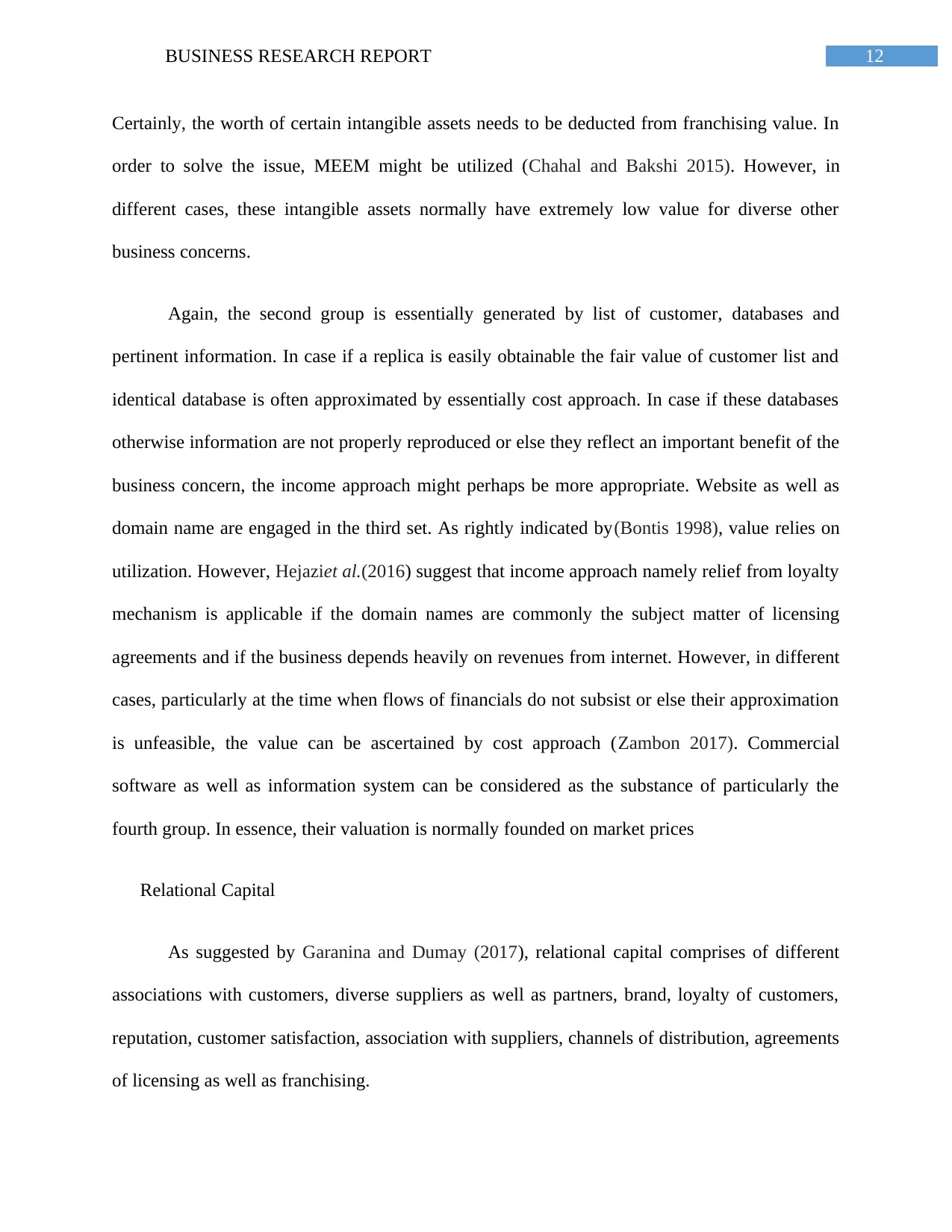
12BUSINESS RESEARCH REPORT
Certainly, the worth of certain intangible assets needs to be deducted from franchising value. In
order to solve the issue, MEEM might be utilized (Chahal and Bakshi 2015). However, in
different cases, these intangible assets normally have extremely low value for diverse other
business concerns.
Again, the second group is essentially generated by list of customer, databases and
pertinent information. In case if a replica is easily obtainable the fair value of customer list and
identical database is often approximated by essentially cost approach. In case if these databases
otherwise information are not properly reproduced or else they reflect an important benefit of the
business concern, the income approach might perhaps be more appropriate. Website as well as
domain name are engaged in the third set. As rightly indicated by(Bontis 1998), value relies on
utilization. However, Hejaziet al.(2016) suggest that income approach namely relief from loyalty
mechanism is applicable if the domain names are commonly the subject matter of licensing
agreements and if the business depends heavily on revenues from internet. However, in different
cases, particularly at the time when flows of financials do not subsist or else their approximation
is unfeasible, the value can be ascertained by cost approach (Zambon 2017). Commercial
software as well as information system can be considered as the substance of particularly the
fourth group. In essence, their valuation is normally founded on market prices
Relational Capital
As suggested by Garanina and Dumay (2017), relational capital comprises of different
associations with customers, diverse suppliers as well as partners, brand, loyalty of customers,
reputation, customer satisfaction, association with suppliers, channels of distribution, agreements
of licensing as well as franchising.
Certainly, the worth of certain intangible assets needs to be deducted from franchising value. In
order to solve the issue, MEEM might be utilized (Chahal and Bakshi 2015). However, in
different cases, these intangible assets normally have extremely low value for diverse other
business concerns.
Again, the second group is essentially generated by list of customer, databases and
pertinent information. In case if a replica is easily obtainable the fair value of customer list and
identical database is often approximated by essentially cost approach. In case if these databases
otherwise information are not properly reproduced or else they reflect an important benefit of the
business concern, the income approach might perhaps be more appropriate. Website as well as
domain name are engaged in the third set. As rightly indicated by(Bontis 1998), value relies on
utilization. However, Hejaziet al.(2016) suggest that income approach namely relief from loyalty
mechanism is applicable if the domain names are commonly the subject matter of licensing
agreements and if the business depends heavily on revenues from internet. However, in different
cases, particularly at the time when flows of financials do not subsist or else their approximation
is unfeasible, the value can be ascertained by cost approach (Zambon 2017). Commercial
software as well as information system can be considered as the substance of particularly the
fourth group. In essence, their valuation is normally founded on market prices
Relational Capital
As suggested by Garanina and Dumay (2017), relational capital comprises of different
associations with customers, diverse suppliers as well as partners, brand, loyalty of customers,
reputation, customer satisfaction, association with suppliers, channels of distribution, agreements
of licensing as well as franchising.
⊘ This is a preview!⊘
Do you want full access?
Subscribe today to unlock all pages.

Trusted by 1+ million students worldwide
1 out of 44
Your All-in-One AI-Powered Toolkit for Academic Success.
+13062052269
info@desklib.com
Available 24*7 on WhatsApp / Email
![[object Object]](/_next/static/media/star-bottom.7253800d.svg)
Unlock your academic potential
Copyright © 2020–2025 A2Z Services. All Rights Reserved. Developed and managed by ZUCOL.